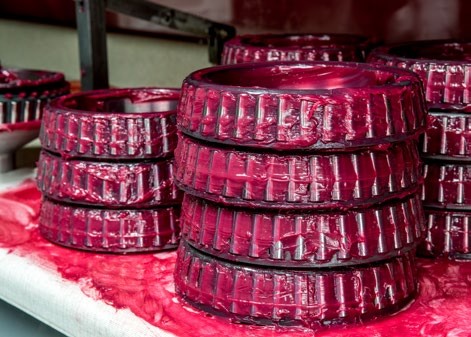Oil bleeding and compatibility in greases

Mobil Aviation Grease on Wheel Bearing.
SOURCE | EXXONMOBIL AVIATION
Q How do the base oil properties vary and what is the impact on the grease?
A Base oils can consist of a wide range of fluids from low-viscosity mineral oils to heavy cylinder stocks to specialized synthetic lubricants. The inherent features seen in a base oil may also be seen in the grease, such as good high-temperature performance, oxidation resistance or low-temperature performance. Base oil selection is generally determined on the desired performance features of the grease. As an example, ExxonMobil Aviation greases are formulated using base oil systems consisting only of synthetic polyalphaolefin (PAO) base oils.
Q What is oil bleed and how does it impact the grease?
A Oil bleed is a term used to explain the separation of oil or seepage of oil from the grease during normal operating or storage conditions. Oil bleed is easily identified by the presence of oily sections of greased components and/or the formation of small pools of oil around componentry.
Excessive oil bleed can impact the grease by causing it to harden, rendering it unsuitable for use.
Q Is it normal for greases to exhibit some oil “bleed” or separation?
A Depending on the storage conditions, duration and temperature, greases can exhibit some degree of oil separation. For example, higher oil separation in a grease can merely be a direct effect of formulating it with a lower-viscosity base oil.
If oil is collecting around the dome or crevices at the top of a grease pail, the oil can be remixed into the grease. If, however, the pail’s surface is completely covered with a layer of separated oil, then operators should contact their supplier before applying the grease.
Again, operators should be wary of instances where more than one type of grease is used to ensure that grease transfer does not cause incompatible greases to come in contact with each other. Incompatible greases may result in an increase in oil bleed.
Q Is there anything we can do to minimize oil “bleed” or separation?
A Yes. You can help minimize oil separation by storing oils in a climate-controlled environment and releasing pressure on the pumping devices used to apply the grease when not in use.
Q Are all greases compatible with one another?
A No, not all greases are compatible, and the mixing of grease brands should not be taken lightly. If commingled greases are incompatible, the grease intermixing can result in reduced performance. All greases contain base oils, thickening agents and chemical additives that can interact adversely if incompatible greases are mixed.
To confirm if grease formulations are compatible, operators can consult the Standard ASTM D6185– Standard Practice for Evaluating Compatibility of Binary Mixtures of Lubricating Greases, which is based on performance data from testing mixtures of both greases.
Most OEM, industry and supplier recommendations suggest performing a compatibility test to assess the risk of mixing two greases. Standard compatibility tests may consider the stability of the oil/thickener matrix by evaluating a grease’s shear stability, dropping point, storage stability and high-temperature performance.
The normal aviation industry practice is to fully purge all old greases from any application, regardless of compatibility. This is a standard operating practice and should be followed without exception.
Q If grease incompatibility occurs, what are some initial effects that might be noticed?
A When incompatible greases are mixed together, the consistency typically becomes harder or softer than the individual greases. These consistency changes generally become more pronounced as operating temperatures and/ or the rate of shearing increases.
While in operation, incompatible greases may also exhibit excessive oil separation or bleeding tendencies. .
This article is courtesy of ExxonMobil Aviation. Find out more information via https://www.exxonmobil.com/en/aviation